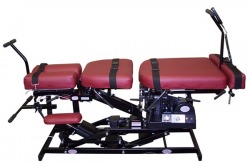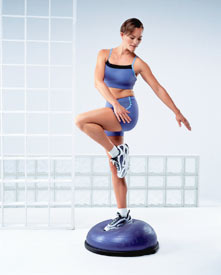Athletes Benefit from Chiropractic
Many athletes have found Chiropractic care to be beneficial. Some of the well known proponents of Chiropractic include Jerry Rice (Retired 49ers receiver), Joe Montana (49ers Quarterback), Chuck Liddell(light heavyweight MMA champion), Jack Lalaine (the original fitness guru), Tiger Woods (regarded as best golfer of all time), Evander Holyfield (former Heavyweight boxing champion), among many others. Please watch the video below with Jerry Rice talking about what chiropractic care has done for him. Many of these athletes, even travel with their own "chiro". Chuck Liddell is known to have his chiro give him a light adjustment immediately before heading to the cage for his fight. Tiger Woods incorporates his chiro into his overall fitness and recovery plan.
As an athlete, you are always pushing to be at the top of your game, all the time. You are demanding the maximum power from your muscles; maximum efficiency from your heart and lungs. If you have ever competed with a slight cold, you know how a minor cold that you would barely notice on a regular day can take you out of the game. In the athletic arena, professional athletes are the first to adopt and try to find an edge. Coaches have developed drills and skill building exercises that have maximized the natural talents of the athlete. The coaches then turned to strength and conditioning to give their athletes an edge over the competition. At this point, most athletes are maximizing their strength and conditioning. Many professional athletes are turning to Chiropractic care to find a new edge.
So, how does Chiropractic offer this edge?
Chiropractic works by removing nerve interference, so you recover from everyday training and minor injuries faster. At Pickaway Chiro, we look at the whole nerve path from the top, where the spinal cord exits the skull all the way to the muscle. We remove any interference that is present. If you have ever had a phone call with a little bit of static , you can appreciate how much a little interference can interfere with communication. When you are competing you want the clearest signal from your brain to your muscles and back again!
How does Dr. Joshua Dick remove the interference?
Dr. Josh uses adjustments to the bones of the spine, arms, and legs to remove subluxations. A subluxation is a slight misalignment of two bones that either directly or indirectly irritates the nerve. He also does extensive soft tissue work. Sometimes, the nerve interference is originating from where the nerve travels through a muscle. For example, the brachial plexus (nerve supply to the arm) exits the spine at the mid neck down to the first rib level. This nerve bundle then travels on the surface of the trapezius muscle. Dr. Josh would first look to the spine to see if there are any subluxations that is causing nerve interference. After checking the spine, he would see if there was any interference in the trapezius area. This could present as a 'knot' in the muscle or a trigger point (tender portion of the muscle). Dr. Josh would then evaluate the rest of the arm to make sure the shoulder, elbow, and wrist are all in proper alignment. There is also several other muscle points that the nerve can become entrapped and irritated. Dr. Josh will then finish checking the rest of the spine and lower extremity.
Tools that Dr. Joshua Dick uses to treat athletes
Dr. Josh not only uses adjustments to treat athletes. He uses mechanical/manual traction, Kinesiotape, instrument assisted myofascial release, passive electric muscle stimulation, active muscle stimulation, theratubing, therapeutic ultrasound, and proprioception tools. What these things are and can offer to benefit the athlete are listed below:
So, how does Chiropractic offer this edge?
Chiropractic works by removing nerve interference, so you recover from everyday training and minor injuries faster. At Pickaway Chiro, we look at the whole nerve path from the top, where the spinal cord exits the skull all the way to the muscle. We remove any interference that is present. If you have ever had a phone call with a little bit of static , you can appreciate how much a little interference can interfere with communication. When you are competing you want the clearest signal from your brain to your muscles and back again!
How does Dr. Joshua Dick remove the interference?
Dr. Josh uses adjustments to the bones of the spine, arms, and legs to remove subluxations. A subluxation is a slight misalignment of two bones that either directly or indirectly irritates the nerve. He also does extensive soft tissue work. Sometimes, the nerve interference is originating from where the nerve travels through a muscle. For example, the brachial plexus (nerve supply to the arm) exits the spine at the mid neck down to the first rib level. This nerve bundle then travels on the surface of the trapezius muscle. Dr. Josh would first look to the spine to see if there are any subluxations that is causing nerve interference. After checking the spine, he would see if there was any interference in the trapezius area. This could present as a 'knot' in the muscle or a trigger point (tender portion of the muscle). Dr. Josh would then evaluate the rest of the arm to make sure the shoulder, elbow, and wrist are all in proper alignment. There is also several other muscle points that the nerve can become entrapped and irritated. Dr. Josh will then finish checking the rest of the spine and lower extremity.
Tools that Dr. Joshua Dick uses to treat athletes
Dr. Josh not only uses adjustments to treat athletes. He uses mechanical/manual traction, Kinesiotape, instrument assisted myofascial release, passive electric muscle stimulation, active muscle stimulation, theratubing, therapeutic ultrasound, and proprioception tools. What these things are and can offer to benefit the athlete are listed below:
Mechanical/Manual Traction~

Mechanical Traction uses a table that pivots at the pelvic level to stretch and flex the low back. This relieves muscle spasms and gives a decompressive effect to the low back. Manual traction is similar to Mechanical traction but is done by hand. Mechanical and manual Traction is especially effective for athletes that undergo collisions, heavy lifting, or spend extended periods of time in a fixed posture. Sports: Football, Power Lifting, Hockey, bikers, and gymnasts.
Kinesiotape~

Kinesiotape is a special tape developed for use on athletes. The tape stretches in all directions so not to limit motion. You may be familiar with the white athletic tape that is used by athletes. This white tape is quite different and has its own use. White tape is used for a short period of time (just as long as the actual competition) then removed. The white tape is used for injured joints and to prevent re-injury. It eliminates a portion of the joint range of motion. This is great for during competition.
Kinesiotape has different therapeutic effects depending on how you apply. It is also applied and left on for 3-5 days at a time. A tight stretched application is used to stimulate the muscles to strengthen the joint and to stabilize a joint. If the joint has been damaged and there is swelling, a light minimal tension is used in the tape to lift the skin and allow the lymphatic system to remove the swelling. Sports: Gymnastics, swimming, volleyball, basketball, and tennis. Shoulders, ankles, quadriceps, and hamstrings are the most common sites for use.
Kinesiotape has different therapeutic effects depending on how you apply. It is also applied and left on for 3-5 days at a time. A tight stretched application is used to stimulate the muscles to strengthen the joint and to stabilize a joint. If the joint has been damaged and there is swelling, a light minimal tension is used in the tape to lift the skin and allow the lymphatic system to remove the swelling. Sports: Gymnastics, swimming, volleyball, basketball, and tennis. Shoulders, ankles, quadriceps, and hamstrings are the most common sites for use.
Instrument Assisted Myofascial Release~

When an athlete has a long standing muscle ‘knot’ the muscle loses some of its strength and flexibility. If the knot is not worked out in a period of time, the connective tissue that surrounds the muscle will scar up and force the muscle to stay knotted. If you have ever seen the silver shiny layer below the fat on the outside of a piece of meat, that is connective tissue. It is a very tough layer. Dr. Josh uses stainless steel tools to assist him in causing this connective tissue to release and to allow the muscle to relax.
Active/Passive Electrical Stimulation~

Active electrical stimulation (Russian Stim.) uses an electric current to activate muscles to contract. While the Russian stimulation is causing the muscle to contract the patient also contracts the muscle using their nerves. This is great for injuries where the nerve signal may have been injured or following wearing a cast. It is an excellent muscle reeducation tool. Passive electrical therapy is used to help relieve muscle tension, decrease swelling, and to relieve pain. Sports: Active is best following a nerve injury (such as a ‘stinger’) Passive is great for a post competition and muscle fatigue.
TheraTubing~

Theratubing is a strength and rehabilitation tool. It is a series of increasing resistance tubing used to strengthen nearly any muscle. The tubing can be sent home with the patient to use for at home care.
Proprioception tools~

We use wobble boards, BOSU balls, and Dyno discs to rehabilitate injured and weak joints. These tools introduce a small instability which causes the muscles to activate and strengthen. The stronger muscles help to compensate until the joint’s ligaments can strengthen and protect the joint.